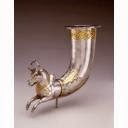And so the second week begins.
After picking up and starting some of the research I left off at last week, Adam came by and took me to the Visitor Engagement meeting that happens every Monday morning, which is ostensibly business but seems like an excuse for donuts, bagels, and conversation more than anything else, not that I'm complaining. After that, I went back to working and wrote two more rough drafts of labels. I haven't gone over the labels in any detail with Adam yet, but hopefully that will happen tomorrow since today sort of got away without it.
In order to talk about the work I have done so far, we ate lunch together downtown, where we went over some of the de-accessioning activities I had observed on Friday with Christie's. He asked my opinion on whether or not each piece was valuable to the collection (this included a marble statue of Apollo, a marble ram that had been on display as a "touching" piece in the 70s, two rather strange terra cotta pieces, and two mosaics, if I didn't list them previously), and so I sort of stumbled through, guessing prices that they had been appraised for as well at his prompting. It seems like the main things taken into consideration include the quality of the pieces, if they fit into the collection cohesively, if there's space for them, and whether or not the collection could be improved with the price the piece would fetch more so than what the piece contributes to it. So rather than telling me all that outright, Adam led me through the reasoning process, and though I did end up feeling rather clumsy, it helped me to understand the mind set and process of a museum much more. We then discussed the Visitor Engagement meeting I had gone to on Thursday and some of the opportunities that the museum has for making decisions as to marketing, including a more data-driven approach. As with any institution, the Toledo Museum seems slow to change, which is obviously not immediately negative, but might lead them to lose out on opportunities to grow and improve in the modern age. Although he didn't think I had entirely missed the point with my labels, there was a mention of editing that implied some rather heavy work, so I am by no means done with any of the labels I drafted, which I am certainly not surprised at.
After returning to the museum, there was a post moratorium meeting for the Fresh Impressions exhibit of Japanese art, mainly prints, that I could have attended, but I managed to lose track of time while reading the doc file and entirely missed it. I don't believe it was a grievous mistake since I would have simply been there to observe and no one was really expecting me, but hopefully something I can avoid in the future. One more mistake to add to the growing list. As of this afternoon, I have drafted 10 labels that I will now revise (probably very heavily), and in pretty much the pairings I had come up with, since Adam approved them. Now I will go through again and add pertinent information that couldn't quite fit within the 75 word limit (though some of mine have turned out to be 75 or so...) which will hopefully be involved in an audio or some other sort of multimedia guide for the exhibit to increase visitor engagement.
Today served very much to solidify the experiences I have had this past week into cohesive thoughts that form more of an understanding of the museum through what I have seen of it. So far, this has enabled me to see the thought process behind exhibitions and visitor engagement, both vital parts of museum functioning which, depending on their execution, very much so determine the quality of the experience and the museum as a whole, since if it does not appeal to the general public and draw them in, then it is not fulfilling its job as a cultural resource to the general public, especially somewhere with free admission like TMA. This includes appealing to the wider populous, not just the small member base that is extremely loyal and dedicated, which in general appears as a pattern throughout Toledo's arts venues. As someone who has traveled through them due to my own interests and socioeconomic status, I consistently run into the same people who attend all of the arts events, myself being one of them, a small fraction of Toledo supporting a vibrant arts scene that the entirety of the city should be aware of and take advantage of. It is not enough to simply have the resources available if we do not reach out and ensure that their value is made known to everyone in the community, not just the choice few who were born and bred with that value in mind.


